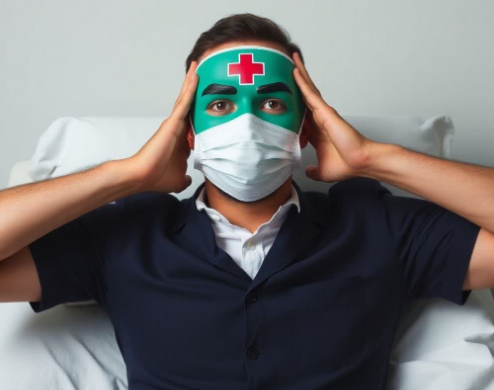"The Silent Scream: When Male Anxiety Masquerades as Medical Emergency"
(Source: The Conversation, by Krista Fisher, Dan Lubman, Simon Rice, and Zac Seidler)
Introduction: The Silent Epidemic of Male Anxiety
Anxiety is a pervasive mental health condition, affecting a significant portion of the population. In Australia, for instance, it's estimated that one in five men will experience anxiety at some point in their lives. Despite its widespread prevalence, anxiety among men remains highly stigmatized, often misunderstood, and consequently, profoundly underdiagnosed. Men are approximately half as likely as women to receive an anxiety disorder diagnosis, a disparity rooted in societal pressures that encourage men to suppress vulnerability, appear fearless, and often lack the vocabulary or understanding to articulate their emotional distress.
This profound gap in recognition and diagnosis has serious, indeed life-threatening, consequences. New research from The University of Melbourne and Monash University reveals a disturbing trend: young men are increasingly turning to emergency ambulance services when their anxiety symptoms become so overwhelming that they believe they are experiencing a life-threatening physical health crisis, such as a heart attack. This alarming pattern begs critical questions: Why do so many men delay seeking conventional support from a general practitioner or psychologist until they are in acute distress, requiring emergency intervention? And what specific factors drive these desperate calls for help? To shed light on this urgent issue, the researchers meticulously reviewed the paramedic notes of 694 young men aged 15 to 25 years in Victoria, Australia.
The Roots of Reluctance: Societal Norms and Missing Role Models
The pervasive stigma surrounding male anxiety is deeply embedded in societal upbringing and expectations:
· Masculinity and Suppression of Vulnerability: Boys are often raised within cultural frameworks that intensely value courage, strength, and unwavering self-assurance. This narrative actively encourages the suppression of emotional vulnerability. When parents, instead of offering comfort, urge boys to "face their fears" in the face of anxiety, it inadvertently positions anxiety as contradictory to masculine ideals. This creates a disconnect between the emotional support young men are taught to expect from others (or themselves) and the genuine emotional comfort they may desperately need.
· Absence of Anxious Male Role Models: This societal conditioning also contributes to a critical absence of visible male role models who openly acknowledge and address their anxiety. Boys grow up with the perception that their fathers, brothers, grandfathers, and even coaches never experience anxiety. This lack of relatable examples further deters boys and men from seeking help, reinforcing the idea that anxiety is a personal failing rather than a common human experience. The direct consequence is that anxiety goes undiagnosed for too long, missing crucial opportunities for early intervention that could mitigate its impact.
While there have been positive shifts in recent years challenging restrictive masculine stereotypes, particularly around men's depression and suicide (leading to increased awareness, normalization of help-seeking, and development of targeted mental health programs), male anxiety has largely remained in the shadows. When conversations about anxiety do occur, they often lack the same weight or concern as those surrounding depression, despite anxiety's significant and harmful health impacts, including driving men towards unhealthy coping mechanisms like alcohol and drug use, and increasing the tragic risk of male suicide.
Anxiety's Disguise: Understanding Its Manifestations in Men
When men are encouraged to articulate their anxiety, they often describe a complex array of challenges that can be easily misinterpreted or dismissed:
· Cognitive and Emotional Symptoms: These include persistent and repetitive worries, a pervasive sense of being "out of control," and intense emotional distress.
· Overwhelming Physical Symptoms: A hallmark of anxiety in men, and a key reason for emergency calls, is the manifestation of severe physical symptoms. These commonly include:
o A high or racing heart rate (palpitations)
o Shortness of breath or difficulty breathing
o Generalized body pains or discomfort
o Tremors or shaking
o Severe headaches
o Numbness or tingling sensations, often in the extremities.
As vividly described by prominent Australian personality Jack Steele (one half of "The Inspired Unemployed") on "The Imperfects Podcast," his experience with anxiety was initially baffling: "I didn’t know what anxiety was. I thought I was the opposite of anxiety." He further elaborated on the profound physical and psychological impact: "The way I explain it, it’s like your whole body just shuts down. My throat starts closing up and my whole body just goes numb. It feels like you’re just so alone. You feel like no one can help you. You genuinely think the world’s ending like there’s no out."
These intense physical sensations are frequently overlooked or dismissed as anxiety symptoms in men, leading to delays in recognition and intervention. The research confirms that when these symptoms are left unaddressed, they typically worsen in severity and frequency, arising in an increasing number of contexts.
Why the Ambulance? The Consequences of Unaddressed Anxiety
The new study, utilizing data from the National Ambulance Surveillance System, provides a stark look into the ultimate consequences of men's anxiety going unaddressed. The findings reveal a critical and concerning trend.
· Anxiety as a Leading Cause of Emergency Calls: Overwhelmed and lacking adequate support, a significant number of young men are turning to ambulances as a last resort in moments of crisis. Alarmingly, anxiety now accounts for 10% of all male ambulance attendances for mental health concerns, surpassing both depression and psychosis. This means one in ten ambulance callouts for mental illness among men is specifically for anxiety-related distress.
"The study identified three common, yet distinct, patterns in how young men's anxiety manifests when they reach out to emergency services."
1. Sudden Onset of Intense Bodily Symptoms Mimicking Life-Threatening Physical Conditions: Many young men experience acute physical sensations so severe and sudden that they genuinely believe they are suffering from a heart attack, stroke, or other critical medical emergency. For instance, the case of Joshua, a 22-year-old, highlights this. While on a tram, he experienced sudden numbness in his hands and feet, accompanied by muscle spasms. Alert but extremely anxious, he sought help from a bystander, convinced of a physical crisis. Paramedics are often called to rule out these life-threatening physical causes first.
2. Severe Anxiety Triggered or Worsened by Substance Use: In an attempt to cope with overwhelming anxiety, some young men turn to alcohol or illicit drugs. This can lead to a dangerous cycle where substance use, intended to quell anxiety, paradoxically exacerbates symptoms or creates new, acute distress. Adam, a 21-year-old, illustrates this. After an anxiety attack at work, he consumed a significant amount of diazepam (Valium) while driving home. Overwhelmed and concerned that his anxiety symptoms hadn't subsided, and worried about the amount of medication he had taken, he called paramedics for help.
3. Mental Health Deterioration with Self-Harm or Suicidal Thoughts, Often Tied to Situational Stressors: For some, unmanaged anxiety spirals into profound mental health deterioration, manifesting as self-harm or suicidal ideation. These crises are frequently exacerbated by significant life stressors such as unstable housing, unemployment, financial difficulties, or severe relationship strain. Leo, a 25-year-old, experienced increasing anxiety for three days before telling his parents he wanted to kill himself, prompting them to call an ambulance. Upon arrival, he confirmed to paramedics his persistent suicidal ideation and worsening condition over the past three months.
Directing Resources and Bridging the Gaps in Care
The high number of young men presenting with anxiety to ambulance services represents a significant strain on emergency resources. Paramedics, while skilled in acute care, often feel ill-equipped to effectively respond to complex mental health crises, particularly after ruling out immediate physical threats. Their typical support is limited to reassurance and basic breathing techniques, usually followed by instructions to seek follow-up care from general practitioners, psychologists, or other community health professionals.
However, the path to ongoing mental health support is fraught with obstacles for these young men. It requires them to:
· Overcome the Stigma: The societal stigma associated with seeking help for mental health issues remains a formidable barrier.
· Confront Shame: The shame of having called an ambulance for what might ultimately be deemed "just" anxiety adds another layer of reluctance.
· Navigate Masculinity Tensions: The deep-seated conflict between acknowledging anxiety and societal expectations of male stoicism creates profound internal tension.
Consequently, many young men "slip through the cracks," failing to engage in sustained mental health support. Without this crucial ongoing care, they face a high risk of repeat presentations to emergency services, often with increasingly severe and entrenched mental health symptoms.
"To effectively address this escalating public health concern, the researchers propose a multi-pronged approach."
1. Elevate Conversations and Take Male Anxiety Seriously: There is an urgent need to openly discuss men's experiences with anxiety and to validate their struggles, signaling that their symptoms are not a sign of weakness but a legitimate health concern.
2. Launch Targeted Awareness Campaigns: Drawing inspiration from successful campaigns that have effectively dismantled the stigma around men's depression and suicide, similar awareness initiatives are needed for male anxiety. These campaigns can normalize help-seeking and provide language for men to understand their experiences.
3. Improve Clinical Diagnosis through Training: Clinicians need better training and up-skilling to recognize and accurately diagnose anxiety disorders in men. This includes understanding the unique and often distinct ways anxiety manifests physically and emotionally in male populations.
4. Create Accessible Pathways to Early Support: Developing user-friendly digital psychological education resources is crucial. These platforms can improve awareness and literacy surrounding men's anxiety experiences, offering discreet and accessible avenues for early support that bypass some of the traditional barriers.
Conclusion: A Call to Action for Men's Mental Health
The rising tide of young men calling ambulances for unmanaged anxiety underscores a critical gap in our mental healthcare system and societal understanding of male emotional health. By perpetuating ideals of stoicism and neglecting to openly discuss and validate male anxiety, we are inadvertently pushing young men to crisis points where their profound emotional distress manifests as terrifying physical symptoms. Addressing this requires a concerted effort to dismantle stigma, improve clinical recognition, and create accessible, early support pathways. Only then can we ensure that young men receive the timely and appropriate care they need, preventing avoidable emergency interventions and fostering a healthier, more resilient future for all.
Labels: "The Silent Scream: When Male Anxiety Masquerades as Medical Emergency"





0 Comments:
Post a Comment
If you have any doubt, please let me know
Subscribe to Post Comments [Atom]
<< Home